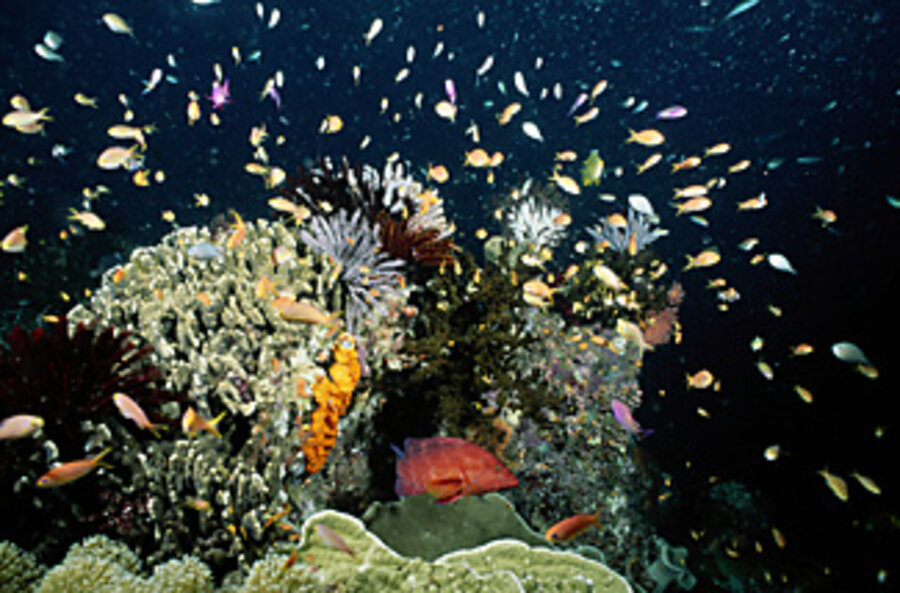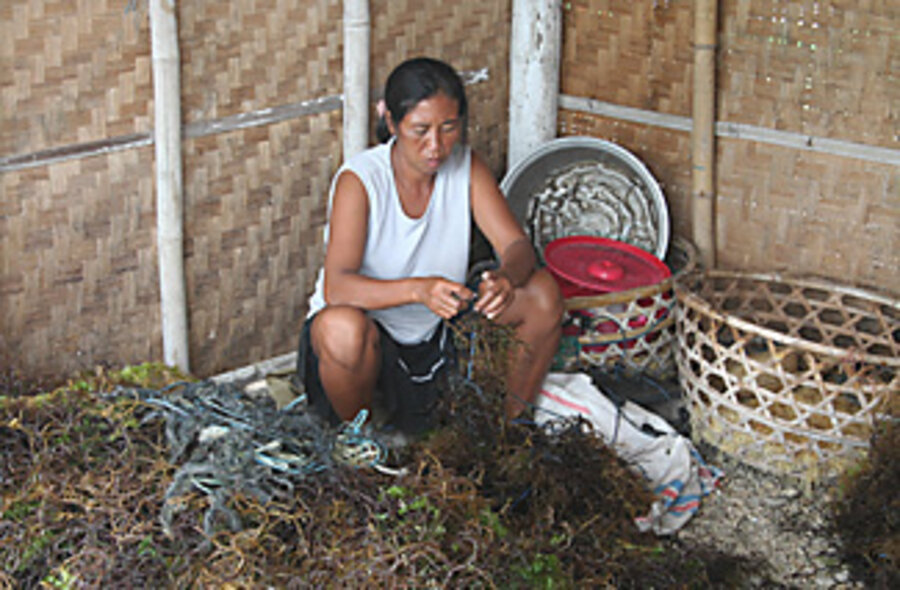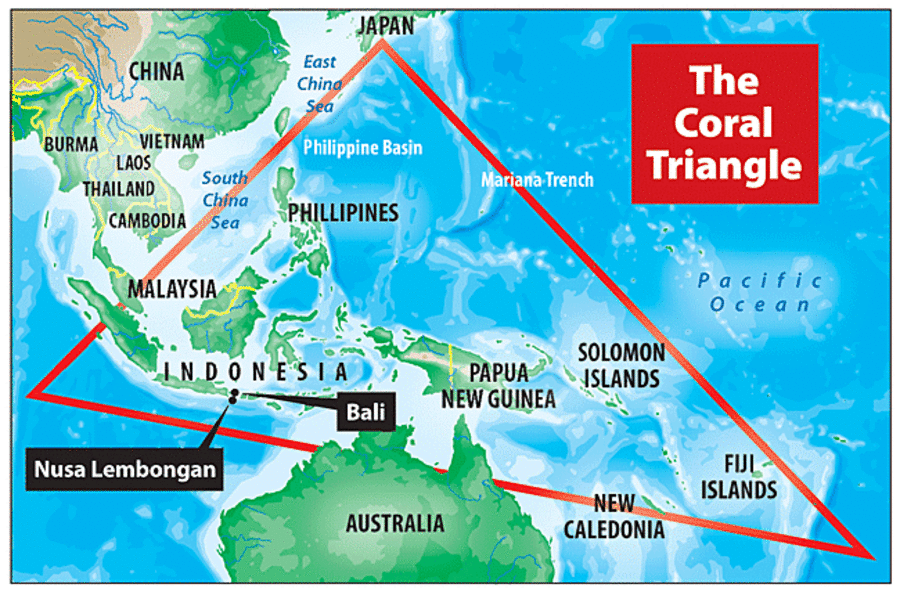Can the crown jewel of world's coral reefs be saved?
Loading...
| Nusa LembongAn, Indonesia
It's 10:39 a.m. on an overcast Tuesday when the skipper points his 40-foot pontoon boat toward a trio of islands off southern Bali. As he clears Benoa Harbor, he opens the throttle on three 250-horsepower outboards. Some guidebooks say the crossing takes 90 minutes. He makes it in 36.
As the boat closes on Nusa Lembongan, the nearest of the three islands, a pod of bottlenose dolphins appears off the starboard side – the first hint visiting landlubbers get of the marine riches these waters hold.
Now, local residents and businesses, conservation groups, and the Indonesian government are laying plans to preserve those riches. In February, the parties are scheduled to meet to begin figuring out how to set up an effective marine-management plan for the islands. The goal is to ensure that the islands' aquatic resources are used in a sustainable way while protecting its most ecologically important areas. It's part of an international effort to shore up the ecological health of a 2.3-million-square-mile expanse of the Indo-Pacific Ocean known as the Coral Triangle.
Sometimes called the ocean's version of the Amazon Basin, the Triangle bursts with the highest biodiversity of any reef system on Earth. Some 75 percent of all the known reef-building corals – 500 to 600 species in all – call the triangle home. By contrast, Australia's Great Barrier Reef hosts some 350 species, while Belize's reefs in Central America host 70. In addition, the triangle supports 3,000 species of reef fish, twice the number found along the Great Barrier Reef or along East Africa's reef network.
For scientists, the origins of this ecological bonanza represent what Old Dominion University marine researcher Kent Carpenter calls "one of the greatest evolutionary and biogeographical mysteries." For some 2.5 million fishermen in the region, the triangle represents their livelihood; among its other attributes, the Coral Triangle is the maternity ward for Pacific and Indian Ocean tuna. And for conservationists, the Triangle represents an important source of raw materials needed to reseed reefs inside and outside the region damaged by bleaching – which many researchers attribute at least in part to global warming.
The challenge, Dr. Carpenter explains, is that "the Coral Triangle in particular has a fairly high percentage of reefs that have been destroyed over the past 20 or so years." The area experienced severe bleaching during the 1997-98 El Niño, one of the strongest in the 20th century. But it also faces other problems. The use of dynamite as a fishing aid, and even the practice of banging corals with rocks to drive fish into nets, "is quite prevalent," he adds. Moreover, some 150 million people live within what might be called the triangle's greater metropolitan area, providing a source of pollution that also undermines corals' ability to survive.
Here amid the shallow-water coral formations off Nusa Lembongan, those pressures seem remote, despite the handful of resorts nestled in the nearby cove. With a diving mask as a picture window and fins for propulsion, visitors' views take in corals that branch, spread platelike, or lay like arrays of flattened cabbage leaves daubed in pastel greens, purples, pinks, and muted russets. A giant clam is half buried near the base of one coral head, while sergeant major fish, surgeonfish, and schools of anthias flit past.
Indeed, one of the factors driving efforts to preserve this small patch of the Coral Triangle is its remarkable variety of marine life, notes Rili Djohani, The Nature Conservancy's country director for Indonesia. The organization is one of three international environmental groups working with regional governments and aid organizations to protect biologically critical spots in the triangle. The group performed a rapid ecological assessment and found that the diversity of coral species here was among the highest in the Coral Triangle. Currents running past Nusa Lembongan and two sister islands bring nutrients up from the deep ocean, turning the seas around them into a five-star feeding ground for dolphins, sharks, rays, and other fish.
Putting it high on the list of coastal areas to preserve "was a no-brainer for us," Ms. Djohani says.
How amazing diversity developed
The story of how this region acquired such biodiversity is thought to begin 55 million years ago, when the three largest Philippine Islands each sat about 1,000 miles apart. As crustal plates shifted, the islands drew closer together. Each island brought with it its own unique blend of marine species. "Most of the species we see today came into existence during this dramatic movement," Carpenter says.
With the coming and going of four ice ages between 1.8 million and 11,500 years ago, sea levels changed dramatically. During the last glacial maximum some 17,000 to 18,000 years ago, for instance, global sea levels were nearly 400 feet below today's levels. This exposed land bridges among several major islands in the Coral Triangle, effectively isolating large groups of marine species, which continued to evolve under new environmental conditions. Once sea levels rose again, the new species rejoined the wider population. Also, two of the most powerful equatorial currents on Earth pass through the region. The currents split and carry larvae from fish, mollusks, and corals over great distances, delivering them to new habitats where – if they survive – they can embark on new evolutionary paths.
Yet while scientists and environmental groups have been working in this marine Amazon for years, only within the past few years has the region risen on the international conservation agenda, says Sian Owen, who heads the policy and external relations activities for the World Wildlife Fund's Coral Triangle program. Rising concerns about the health of the oceans in general have played a part. But concerns also have grown about the potential economic, political, and security implications for the region if the triangle no longer can serve as an economic bulwark. Beyond the terrorist bombings in Bali in 2002 and 2005, the region already has seen a surge of Islamic fundamentalism. This raises the specter of political instability if a major piece of the region's economic mosaic disappears.
One sign that countries are taking the Coral Triangle more seriously came last month in Bali. There, top officials from Indonesia, Malaysia, Papua New Guinea, the Philippines, the Solomon Islands, and Timor-Leste – the six Coral Triangle nations – agreed to develop an action plan for sustainable management of the triangle.
The hope is to have the plan ready in May and fully approved the following year at a summit held in conjunction with the World Oceans Conference in Manado, Sulawesi. The Asian Development Bank, the Global Environment Facility, and the World Bank are devising approaches to help the six pay for their efforts. The United States has donated $4.35 million toward the goal.
Conservation helps islanders, too
In the meantime, conservation efforts in individual countries continue. And researchers are attacking a range of scientific and sociological questions related to building marine protected areas.
In late November, The Nature Conservancy released a study looking at whether establishing conservation programs – which include setting up alternate sources of income for inhabitants, such as seaweed farms or a cut of the fees tourists pay to enter national parks – can help reduce poverty in the region. Although the results in the four marine protected areas varied, overall, the study found that people in each were better off. More homes are sprouting satellite-TV dishes, peoples' diets are improving, and more children are finishing elementary school, says The Nature Conservancy's Ms. Djohani.
Still, experience is teaching some tough lessons, she says. In Komodo National Park, incentives to stop dynamite fishing worked spectacularly well; the use of TNT dropped by some 90 percent. But people who had followed the rules all along – and so didn't qualify for incentives – said they felt "we were rewarding the bad guys." The approach triggered some resentment, and so officials devised a package to reward good behavior.







